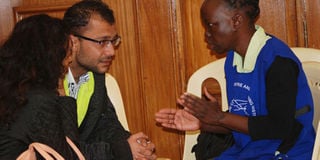How attack opened private cultural centre to the world

Orpah Apola (in blue) from Amani Counselling Centre takes some of the Westgate attack respondents through psychological first aid on September 24, 2013 at Oshwal Centre. Photo/DENISH OCHIENG
What you need to know:
- The Oshwal Centre in Nairobi’s Parklands neighbourhood is a place where Oshwals — a group that follows the Jainism religion and traces its roots to India — meet for religious, cultural and social activities.
In the midst of the Westgate shopping mall attack last week, one usually private place gained prominence because of its humanitarian response to victims.
The Oshwal Centre in Nairobi’s Parklands neighbourhood is a place where Oshwals — a group that follows the Jainism religion and traces its roots to India — meet for religious, cultural and social activities.
But, after the siege began that Saturday afternoon, the centre became a safe haven for hundreds of victims from all walks of life as the centre set up camp, and they received much needed help.
Mr Rashmi Shah, the chairman of the Visa Oshwal Community, was at the centre when the mall assault began. He told Sunday Nation that at 12.30 pm, around 700 Oshwals were preparing for a religious event scheduled for the following day.
“At around this time, reports started coming in that shootings were going on at Westgate; that there was a problem there,” he said.
At that point, the community members thought there was a robbery going on. They had no idea how bad things would get.
But just in case, they closed the centre’s gates for their own protection.
But they kept hearing sustained gunfire and soon found out that what was going on at the mall was likely a terrorist attack. At 2.30 pm, a crowd started gathering outside the Oshwal gate.
“We thought they were curious members of the public,” Mr Shah said. “Then, a security guard came and told me that the individuals had come from Westgate and they wanted to enter.”
So Mr Shah advised him to open the gate. Some of the people had minor injuries while others were traumatised by what they termed a horrible shootout.
The Oshwal Centre was then transformed into a public venue.
“At that stage, the gates were open for everybody: black, brown and white. This was on humanitarian grounds,” Mr Shah said.
The Oshwals present became volunteers and soon other members of Kenya’s South Asian community arrived to lend a hand.
“We started treating the wounded, listening to them, giving them food and water, charged their phones and had them use ours to contact their relatives,” Mr Shah said. “We even welcomed their relatives and friends inside the centre.”
Later, about four Kenya Red Cross volunteers arrived and the volunteers sought their assistance. They began counselling the victims and, before long, about 50 more Kenya Red Cross volunteers arrived in ambulances that brought more injured people.
By Wednesday, nearly 400 injured people had passed through the centre’s gate, with 300 volunteers both from the Oshwal community and aid agencies offering assistance.
A first aid area was set up in the building’s basement, a helpline and missing person’s list were opened, a conference room was made available, journalists showed up, South Asian youths controlled traffic, and volunteers did what they could as victims who were in serious condition were taken to hospitals.
It didn’t end there. A 24-hour kitchen was opened on Saturday. Surplus food was sent to the nearby MP Shah and Aga Khan hospitals.
Mr Shah said the Oshwal community lost two members in the attack. He reckons the reason why people sought assistance from the centre is because of its proximity to the mall that is less than 600 metres away.
He cited the assistance offered as being totally on humanitarian grounds, which is understandable when you look at the foundation of the Oshwals’ faith.
The history of the Visa Oshwal community goes back to India.
RAILWAY BUILDERS
“More than a hundred years ago, residents of a village in the Jamnagar area on the western coast came to Kenya,” Mr Shah said. “They were facing a drought back home but had heard of their fellow Indians who said interesting things about Kenya where they had gone to construct a railway.”
They wanted to know what East Africa was all about.
“Travelling using dhows, the Indians reached Mombasa. Some stayed there while others moved to different parts of the country,” Mr Shah said.
Over time, more Jains from Jamnagar arrived and slowly began to establish schools, temples and community centres from donations. Their oldest place of worship is the 90-year-old Jain Temple on Keekorok Road in Nairobi.
Individuals also opened shops, notably on Nairobi’s Biashara Street, Njugu Lane and River Road. Mr Shah estimates that there are 11,000 Oshwals in Kenya. Someone becomes part of this community, whose native language is Gujarati, if they are born into an Oshwal family.
Today, Oshwal Centres are found in Nairobi, Mombasa, Kisumu, Nakuru and Kitale.
The act of charity portrayed by Oshwals is best embodied in Jainism which is a religion that prescribes a path of non-violence towards all living beings in addition to emphasising spiritual independence and equality.
“The religion teaches us that the basic things are non-violence and tolerance,” Mr Shah said.





